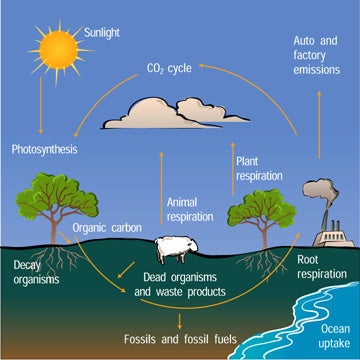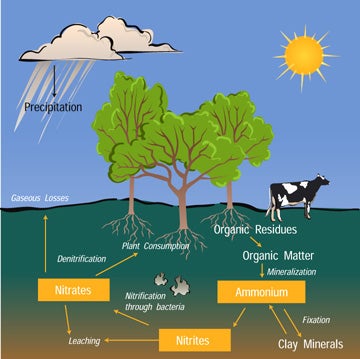How Do Animals Get The Carbon And Nitrogen They Need
There are a few types of atoms that tin can be a part of a constitute one mean solar day, an animal the next day, and so travel downstream every bit a part of a river's water the following solar day. These atoms can be a part of both living things like plants and animals, also as not-living things like h2o, air, and even rocks. The same atoms are recycled over and over in different parts of the World. This blazon of cycle of atoms between living and non-living things is known as a biogeochemical bike.
All of the atoms that are building blocks of living things are a part of biogeochemical cycles. The most common of these are the carbon and nitrogen cycles.
Tiny atoms of carbon and nitrogen are able to movement around the planet through these cycles. For example, an cantlet of carbon is captivated from the air into the ocean water where information technology is used by niggling floating plankton doing photosynthesis to get the nutrition they need. There is the possibility that this piddling carbon cantlet becomes part of the plankton's skeleton, or a part of the skeleton of the larger brute that eats information technology, and then function of a sedimentary stone when the living things die and only basic are left behind. Carbon that is a role of rocks and fossil fuels like oil, coal, and natural gas may be held abroad from the rest of the carbon bike for a long time. These long-term storage places are called "sinks". When fossil fuels are burned, carbon that had been underground is sent into the air as carbon dioxide, a greenhouse gas.
Recently, people have been causing these biogeochemical cycles to change. When we cut down forests, make more factories, and drive more cars that burn fossil fuels, the way that carbon and nitrogen move around the Globe changes. These changes add together more greenhouse gases in our atmosphere and this causes climate change.
The Carbon Cycle

The element carbon is a role of seawater, the atmosphere, rocks such as limestone and coal, soils, too as all living things. On our dynamic planet, carbon is able to move from 1 of these realms to another every bit a part of the carbon cycle.
- Carbon moves from the atmosphere to plants. In the atmosphere, carbon is attached to oxygen in a gas called carbon dioxide (COtwo). Through the procedure of photosynthesis, carbon dioxide is pulled from the air to produce nutrient made from carbon for plant growth.
- Carbon moves from plants to animals. Through food chains, the carbon that is in plants moves to the animals that eat them. Animals that eat other animals get the carbon from their food likewise.
- Carbon moves from plants and animals to soils. When plants and animals die, their bodies, wood and leaves decays bringing the carbon into the ground. Some is buried and will get fossil fuels in millions and millions of years.
- Carbon moves from living things to the temper. Each time you exhale, you are releasing carbon dioxide gas (CO2) into the atmosphere. Animals and plants need to go rid of carbon dioxide gas through a procedure called respiration.
- Carbon moves from fossil fuels to the atmosphere when fuels are burned. When humans burn fossil fuels to ability factories, ability plants, cars and trucks, well-nigh of the carbon rapidly enters the atmosphere as carbon dioxide gas. Each year, five and a half billion tons of carbon is released by burning fossil fuels. Of this massive corporeality, 3.3 billion tons stays in the atmosphere. Nearly of the remainder becomes dissolved in seawater.
- Carbon moves from the atmosphere to the oceans. The oceans, and other bodies of water, blot some carbon from the temper. The carbon is dissolved into the water.
Carbon dioxide is a greenhouse gas and traps estrus in the atmosphere. Without it and other greenhouse gases, World would be a frozen world. Only since the starting time of the Industrial Revolution nigh 150 years ago humans take burned and so much fuel and released and so much carbon dioxide into the air that global climate has risen over ane caste Fahrenheit. The atmosphere has non held this much carbon for at to the lowest degree 420,000 years according to data from ice cores. The recent increase in amounts of greenhouse gases such equally carbon dioxide is having a significant impact on the warming of our planet.
Carbon moves through our planet over longer time scales as well. For example, over millions of years weathering of rocks on land can add carbon to surface water which eventually runs off to the bounding main. Over long time scales, carbon is removed from seawater when the shells and bones of marine animals and plankton collect on the ocean floor. These shells and bones are fabricated of limestone, which contains carbon. When they are deposited on the sea floor, carbon is stored from the residual of the carbon wheel for some amount of time. The amount of limestone deposited in the ocean depends somewhat on the amount of warm, tropical, shallow oceans on the planet because this is where prolific limestone-producing organisms such as corals live. The carbon can be released back to the temper if the limestone melts or is metamorphosed in a subduction zone.
The Nitrogen Cycle

Nitrogen is an element that is found in both the living portion of our planet and the inorganic parts of the Earth arrangement. Nitrogen moves slowly through the cycle and is stored in reservoirs such every bit the atmosphere, living organisms, soils, and oceans along the way.
Most of the nitrogen on Earth is in the temper. Approximately fourscore% of the molecules in World'southward atmosphere are made of two nitrogen atoms bonded together (N2). All plants and animals need nitrogen to make amino acids, proteins and Dna, simply the nitrogen in the temper is non in a form that they can apply. The molecules of nitrogen in the atmosphere tin become usable for living things when they are broken apart during lightning strikes or fires, by certain types of bacteria, or by leaner associated with legume plants. Other plants get the nitrogen they need from the soils or water in which they alive mostly in the form of inorganic nitrate (NO3-). Nitrogen is a limiting factor for plant growth. Animals get the nitrogen they need by consuming plants or other animals that incorporate organic molecules equanimous partially of nitrogen. When organisms die, their bodies decompose bringing the nitrogen into soil on land or into the oceans. As dead plants and animals decompose, nitrogen is converted into inorganic forms such as ammonium salts (NH4+) by a procedure called mineralization. The ammonium salts are absorbed onto clay in the soil and then chemically altered by bacteria into nitrite (NOii-) and then nitrate (NO3-). Nitrate is the form normally used by plants. It is easily dissolved in water and leached from the soil system. Dissolved nitrate tin exist returned to the temper by certain leaner through a procedure called denitrification.
Sure actions of humans are causing changes to the nitrogen cycle and the amount of nitrogen that is stored in reservoirs. The utilise of nitrogen-rich fertilizers tin cause nutrient loading in nearby waterways as nitrates from the fertilizer wash into streams and ponds. The increased nitrate levels cause plants to grow rapidly until they use up the nitrate supply and dice. The number of herbivores will increment when the plant supply increases and and so the herbivores are left without a food source when the plants die. In this fashion, changes in food supply will affect the entire food chain. Additionally, humans are altering the nitrogen bike by burning fossil fuels and forests, which releases diverse solid forms of nitrogen. Farming as well affects the nitrogen cycle. The waste associated with livestock farming releases a big amount of nitrogen into soil and water. In the aforementioned manner, sewage waste adds nitrogen to soils and water.
Nitrogen and Air Pollution

An unsightly haze of smog, visible from NCAR'due south Mesa Laboratory, rests over Bedrock Valley.
UCAR
Nitric oxide (NO) and nitrogen dioxide (NO2) are together known every bit nitrogen oxides. These nitrogen oxides contribute to the trouble of air pollution, playing roles in the formation of both smog and acid rain. They are released into World's atmosphere by both natural and human-generated sources.
Nitric oxide is a colorless, flammable gas with a slight olfactory property. Nitrogen dioxide is a deep ruby-orange gas that is poisonous but non flammable. Information technology, along with aerosols, is responsible for the ruby-red-brown colour of smog. At high concentrations, it is highly toxic and can crusade serious lung damage. Nitrogen dioxide is a strong oxidizing agent, and is thus very reactive with other compounds.
Scientists gauge that betwixt 20 and ninety 1000000 tons of nitrogen oxides in produced naturally each year from sources such as volcanoes, oceans, biological disuse, and lightning strikes. Human activities add another 24 1000000 tons of nitrogen oxides to our atmosphere annually.
Both NO and NO2 are formed during high-temperature combustion in the atmosphere, when oxygen combines with nitrogen. The exhaust gases of cars and trucks are major sources of nitrogen oxides, as are the emissions from electrical power generation plants. Motorcar frazzle has more NO than NOtwo, but once the NO is released into the atmosphere it quickly combines with oxygen in the air to form NO2.
Nitrogen oxides are at to the lowest degree partially responsible for several types of air pollution. Nitrogen dioxide lends its color to the red-chocolate-brown haze we call smog. Photodissociation of nitrogen dioxide by sunlight produces nitric oxide and ozone in the troposphere, which is some other component of smog. A series of chemical reactions transform Volatile Organic Compounds (VOCs) into substances that combine with nitrogen dioxide to produce PAN (Peroxyacytyl nitrate), yet another chemical element in smog. Nitrogen dioxide in the air likewise reacts with water vapor to form nitric acid, ane of the types of acid in acid rain. Nitric oxide concentration in unpolluted air is effectually 0.01 ppm. In smog, the concentration rises twenty-fold to about 0.2 ppm.
Although nitrogen oxides have gained dubious distinction as pollutants, they are too used beneficially in some industrial processes. Nitric oxide is manufactured on a large calibration, and is subsequently used to make nitric acid (HNOthree). To create nitric oxide for industrial uses, chemists combine ammonia (NHthree) with oxygen (Oii), releasing water (H2O) as a byproduct. Nitrogen compounds derived from nitric acrid are used to create chemical fertilizers, explosives, and other useful substances.
© 2011 NESTA with modifications by UCAR
Source: https://scied.ucar.edu/learning-zone/earth-system/biogeochemical-cycles
Posted by: johnsonhicither.blogspot.com

0 Response to "How Do Animals Get The Carbon And Nitrogen They Need"
Post a Comment